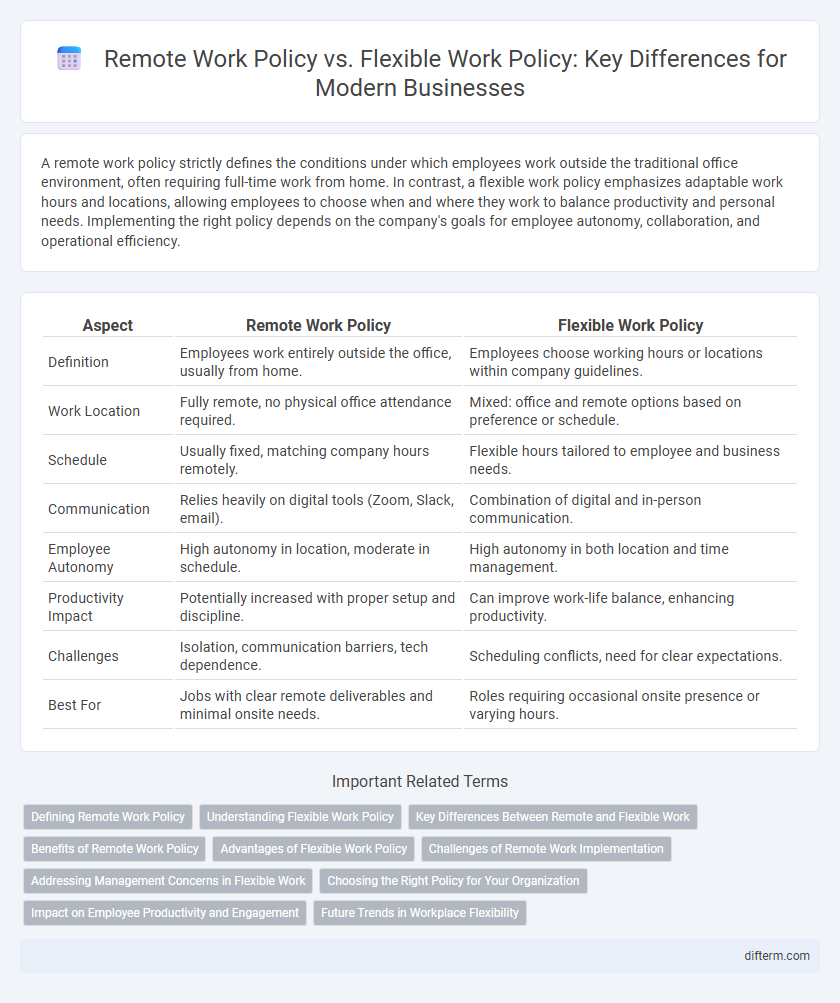A remote work policy strictly defines the conditions under which employees work outside the traditional office environment, often requiring full-time work from home. In contrast, a flexible work policy emphasizes adaptable work hours and locations, allowing employees to choose when and where they work to balance productivity and personal needs. Implementing the right policy depends on the company's goals for employee autonomy, collaboration, and operational efficiency.
Table of Comparison
| Aspect | Remote Work Policy | Flexible Work Policy |
|---|---|---|
| Definition | Employees work entirely outside the office, usually from home. | Employees choose working hours or locations within company guidelines. |
| Work Location | Fully remote, no physical office attendance required. | Mixed: office and remote options based on preference or schedule. |
| Schedule | Usually fixed, matching company hours remotely. | Flexible hours tailored to employee and business needs. |
| Communication | Relies heavily on digital tools (Zoom, Slack, email). | Combination of digital and in-person communication. |
| Employee Autonomy | High autonomy in location, moderate in schedule. | High autonomy in both location and time management. |
| Productivity Impact | Potentially increased with proper setup and discipline. | Can improve work-life balance, enhancing productivity. |
| Challenges | Isolation, communication barriers, tech dependence. | Scheduling conflicts, need for clear expectations. |
| Best For | Jobs with clear remote deliverables and minimal onsite needs. | Roles requiring occasional onsite presence or varying hours. |
Defining Remote Work Policy
A Remote Work Policy clearly outlines the expectations, responsibilities, and guidelines for employees who work entirely or primarily outside the traditional office environment. It typically covers aspects such as work hours, communication protocols, technology requirements, data security, and performance metrics tailored to remote settings. Establishing this policy ensures consistency, accountability, and effective management of a fully or partly remote workforce.
Understanding Flexible Work Policy
Flexible work policy allows employees to customize their work hours and locations beyond traditional office settings, promoting work-life balance and increasing productivity. Unlike remote work policy, which primarily focuses on working outside the office, flexible work policy includes options such as staggered hours, compressed workweeks, and hybrid schedules. Implementing a flexible work policy can enhance employee satisfaction, reduce turnover rates, and attract top talent in competitive business markets.
Key Differences Between Remote and Flexible Work
Remote Work Policy mandates employees to work outside the traditional office environment, often from home, while Flexible Work Policy allows variability in work hours, locations, or methods to suit employee needs. Remote policies emphasize location independence with specific communication and productivity guidelines, whereas flexible policies prioritize adaptability in scheduling and work-life balance. Organizations implementing remote work typically invest in digital collaboration tools, yet those adopting flexible work focus on outcome-based performance metrics and employee autonomy.
Benefits of Remote Work Policy
Remote Work Policy enhances employee productivity by eliminating commute time and offering a personalized work environment, leading to higher job satisfaction and retention rates. This policy reduces operational costs for businesses by minimizing the need for physical office space and associated expenses. Companies adopting remote work also experience access to a broader talent pool, enabling recruitment of diverse professionals across different geographical locations.
Advantages of Flexible Work Policy
Flexible work policies enhance employee productivity by allowing individuals to tailor their schedules to peak performance hours, reducing burnout and increasing job satisfaction. These policies support a healthier work-life balance, which can lead to lower turnover rates and higher retention in competitive industries. Companies adopting flexible work arrangements often see improved collaboration and creativity, as employees engage more effectively when given autonomy over their work environment and hours.
Challenges of Remote Work Implementation
Remote work implementation faces challenges such as ensuring consistent communication, maintaining employee productivity, and securing sensitive data across diverse home environments. Organizations must invest in reliable technology and cybersecurity measures while providing ongoing training to manage remote teams effectively. Balancing employee autonomy with accountability presents a critical hurdle in sustaining performance and engagement in remote work settings.
Addressing Management Concerns in Flexible Work
Flexible Work Policy addresses management concerns by enabling clear guidelines on employee availability, productivity metrics, and communication protocols, ensuring accountability outside traditional office hours. This policy supports trust-building through regular performance evaluations and technology-enabled monitoring tools tailored to individual roles. Incorporating flexible scheduling reduces resistance by aligning work-life balance needs with organizational goals, fostering a results-driven culture.
Choosing the Right Policy for Your Organization
Evaluating the specific needs of your workforce and organizational goals is crucial when choosing between a Remote Work Policy and a Flexible Work Policy. Remote Work Policies typically emphasize location independence, enhancing productivity for roles that do not require physical presence, while Flexible Work Policies focus on variable working hours to better accommodate employee work-life balance. Analyzing job functions, team collaboration requirements, and employee preferences ensures the selected policy maximizes efficiency and engagement.
Impact on Employee Productivity and Engagement
Remote work policy significantly enhances employee productivity by minimizing commute time and providing personalized work environments, resulting in increased focus and efficiency. Flexible work policy boosts engagement by allowing employees to tailor their schedules around peak productivity periods and personal responsibilities, fostering job satisfaction and reducing burnout. Both policies contribute to improved performance but cater to different aspects of work-life balance and operational needs.
Future Trends in Workplace Flexibility
Future trends in workplace flexibility emphasize the integration of remote work policies with broader flexible work arrangements, including hybrid schedules and results-oriented performance metrics. Companies increasingly invest in digital collaboration tools and employee well-being programs to support adaptability and productivity beyond physical office constraints. Data shows that organizations adopting flexible work policies report higher employee satisfaction, reduced turnover, and improved talent acquisition in competitive markets.
Remote Work Policy vs Flexible Work Policy Infographic

 difterm.com
difterm.com